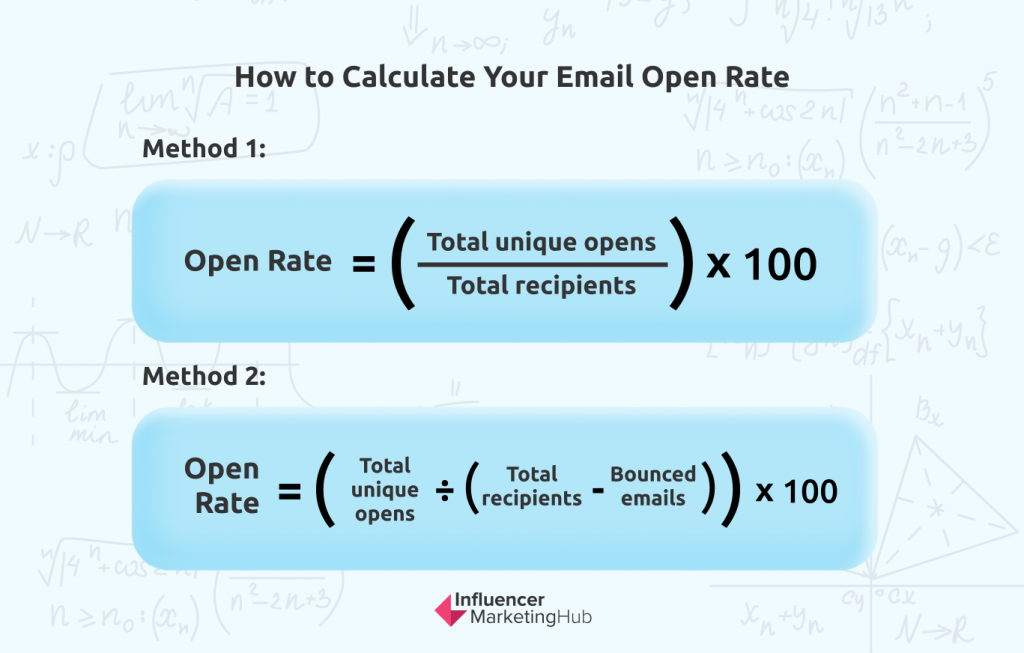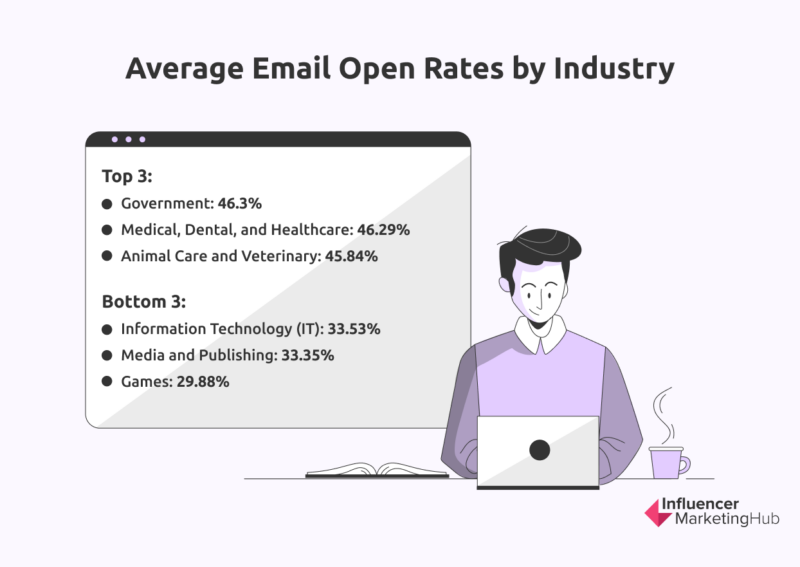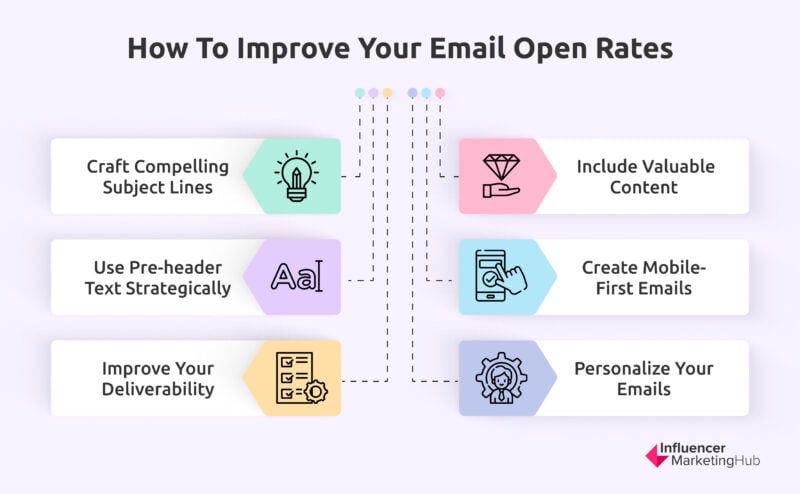Is your email marketing as effective as you want it to be?
One of the first things to do if you're not getting the return you want on your email marketing investment is to check your open rates. Open rates are a great indicator of how engaged your email subscribers are in your content and your brand. A low open rate might mean that your segments are off, you're reaching the wrong people, or your content is lacking creativity. But what even is a good email open rate for your industry? And, maybe most importantly, how can you fix low email open rates?
Here we'll answer all your questions about average email open rates by industry in 2024, why open rates are so important, and how you can fix yours if they're low.
Let's get started!
Average Email Open Rates by Industry 2024:
Email Marketing? Still?
Year after year, many words are spilled over how "dead" email marketing is. And, year after year, email marketing proves that it's still one of the strongest marketing channels around. The definition of a "good" ROI varies depending on the context. In the case of stocks, a 7% ROI is considered satisfactory, while for larger companies, a figure close to 10% is excellent. On the other hand, for small businesses, a desirable ROI range would be between 15% to 30%.
That means for every $1 you spend on email marketing, you have the potential to get back $36! Sure, it's one of the oldest digital marketing channels, but the fact that email is still going strong after all these years is a testament to its effectiveness.
It shouldn't come as a surprise that email marketing is so powerful. After all, more than 4 billion people worldwide use email (The Radicati Group)—nearly 52% of the entire world population. And, a whopping 60% of those email users say they enjoy receiving promotional emails weekly. What that means to you is that email marketing is probably important for your brand. If you're not already, you should be using it. If you're already using email marketing, you should be tracking your email marketing benchmarks to make sure you're getting the most from your investment.
Email Marketing Benchmarks
Email marketing benchmarks are how you track the performance of your email marketing campaigns. While we're focusing on email open rates here, there are several benchmarks and metrics that are important to follow. Tracking and measuring your benchmarks can help you build stronger strategies, so you can continue to grow your business year after year.
What Is an Open Rate?
An open rate is a term used to describe the percentage of email recipients that opened an email after receiving it. It's a pretty simple concept for something that can provide email marketers so much information about the effectiveness of their email marketing campaigns or the viability of their email marketing list. Here's how to calculate your email open rate:

Your email marketing service provider should be able to give you granular information about your email open rates, right down to email marketing metrics for individual subscribers on your list. Open rates are a great way to find the people on your list that aren't engaged with your content, so you can target them with a winback campaign (sometimes called a re-engagement campaign) with the goal of cleaning the inactive and disengaged subscribers from your list. We recommend cleaning your email list at least once each year.
What Is a Good Email Open Rate?
A good email open rate is one that meets the average across industries—right around 17% - 28%. Having said that, different industries have different average open rates. The best way to determine a good email open rate for your business is by tracking your actual open rates for a full quarter and averaging them. That gives you a benchmark against which you can measure your open rates over time to ensure that they keep improving.
Why Do Open Rates Matter?

Your open rate can tell you a number of things about a specific email or email marketing campaign:
- If your email made it to the inbox and didn't get caught up in increasingly powerful spam filters
- If you targeted the right segment of your audience
- If your subject line was compelling enough to get folks to open the email
- If your preheader text was engaging
We don't need to tell you that if nobody opens your emails, you're not going to get a great return on your email marketing investment. That has a ripple effect—if nobody opens your emails, they're not clicking through to your landing or sales pages, and if they're not doing that, you're not making sales. If you have low open rates, these are the things you can test.
Average Email Open Rates by Industry—Benchmarks for 2024

So, what are the average email open rates by industry? In this section, we're going to share details from Email marketing benchmarks for 2024. As you'll see, government enjoys the highest email open rates at 46.3% with medical, dental and healthcare coming in second at 46.29% and animal care and veterinary rounding out the top three at 45.84%. Given the fact that the last few years were filled with uncertainty, it's not really surprising that these three industries saw increases over previously reported numbers.
On the other side of things, the bottom three industries for email open rates are information technology (33.53%), media and publishing (33.35%), and closing it down with games getting an email open rate of 29.88%.
The Difference Between B2B and B2C Emails
There's a slight difference in email open rates between B2B and B2C industries. According to the Smarts Insights, B2C emails average a 19.7% open rate. B2B emails get a lower open rate of 15.1%.
Email Open Rates Depend on the Type of Email
Email type also has an impact on open rates. According to reports by Flodesk, welcome emails have a mind-blowing 86% open rate, and transactional emails are lower, averaging between 40–50%. This is important to note because many brands miss out on prime marketing opportunities by not taking advantage of transactional and welcome emails.
Improving Your Email Open Rates

If you have low email open rates, there are a few things you can do to improve them. The best part? This will have an effect on other aspects of your marketing campaigns, too. Let's take a look at some email marketing tips to improve open rates, no matter your industry.
Craft Compelling Subject Lines
Your subject line plays an enormous role in getting email recipients to open your emails. Effective subject lines should grab readers' attention and entice them to click on your email. This usually means using subject lines that pique curiosity or evoke emotion.
Here are a few quick tips for improving your email subject lines:
- Keep it short
- Include emoji
- Use personalization
- Add numbers
- A/B test
Use Pre-header Text Strategically
Pre-header text is 3–250 characters that show up on some email clients under the subject line. Some don't show them at all, so make sure your subject line and email work just as well without them, too. Since they're so short, you'll want to start your pre-header text with the most interesting information. Here are some tips to create compelling pre-header text:
- Make it unique (don't just repeat the subject)
- Build curiosity instead of summarizing what's in the email
- Add a call to action
Improve Your Deliverability
Email deliverability is super important to all email marketers. High deliverability means that your emails are more likely to get to your recipients' inboxes instead of getting relegated to spam or bouncing back. Here are some tips for email deliverability do to make sure that your emails make it to the inbox:
- Keep your email list clean
- Use proper spelling and grammar
- Make sure you're in compliance with email marketing regulations like the CAN-SPAM Act and GDPR
Include Valuable Content
If the only thing you ever do with your emails is to try to sell to your subscribers, they're eventually going to stop opening your emails. That's why it's so important to include a mix of email types in your email marketing strategy and include content that's educational, entertaining, and engaging for your subscribers. The more valuable your emails are to your readers, the more likely they are to open your emails.
Create Mobile-First Emails
According to Constant Contact, mobile devices account for 63% of email opens as of 2023. That's a huge chunk of recipients you'll miss out on if your emails aren't at least mobile-friendly. Here's how to make sure that your emails work well for mobile email users:
- Use a single-column email template
- Keep design and content short, sweet, and concise
- Use size-appropriate fonts that are easy to read
- Cut down on images
- Use a single call to action
Design Emails That Shine on Mobile
With the majority of email opens happening on mobile, Constant Contact helps you create mobile-first emails effortlessly. Use their templates and design tools to craft concise, visually optimized messages that drive engagement on any device. Try it today!
Personalize Your Emails
Personalization has been trending in email marketing for years, and with good reason: roughly 88% of marketers in the United States see measurable improvement in campaign performance thanks to personalization (Instapage). Here are some ways you can increase personalization and improve your email open rates:
- Segment subscribers right away
- Use subscribers' names
- Use dynamic content
- Send emails in recipients' time zones
- Pay attention to the email data you have to find out what emails resonate
Wrapping Up
Email marketers always want to know how their campaigns and individual emails are performing and open rates are the first and most obvious indication that your marketing messages are resonating with your target audience. You can use the email open rates by industry to see how your own emails are performing, but we strongly encourage you to use those numbers as a goal and check your own email marketing data to establish a benchmark against which to measure your performance.
An email open rate is the percentage of email recipients who open an email after receiving it. It is calculated by dividing the number of emails opened by the number of emails delivered, then multiplying by 100. A good email open rate generally falls between 17% and 28%, depending on the industry. The best way to determine a good open rate for your business is by tracking your own open rates over a period of time and averaging them. Email open rates matter because they indicate how engaged your email subscribers are with your content. High open rates suggest that your subject lines and preheader text are effective, your email list is well-targeted, and your emails are successfully reaching recipients' inboxes instead of spam folders. According to recent benchmarks: To improve your email open rates, you can:Frequently Asked Questions
What is an email open rate?
What is a good email open rate?
Why do email open rates matter?
What are the average email open rates by industry for 2024?
How can I improve my email open rates?


